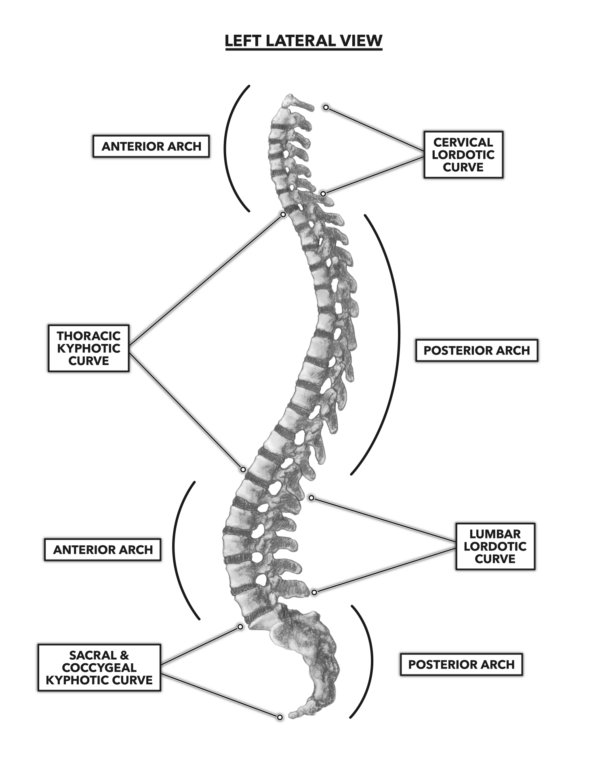The vertebral column has two types of curves (Figure 1):
- kyphotic curve – an anterior arch of the vertebral column. The most recognized kyphotic curve is formed by the posterior arching of the thoracic vertebrae.
- lordotic curve – a posterior arch of the vertebral column. The most visible lordotic curve is formed by the anterior arching of the lumbar vertebrae.
A degree of kyphosis and lordosis is necessary to provide ergonomic support for the internal viscera and the body as a whole. Think of it as a structural solution to the torque that would be applied by hanging all the viscera and muscles on the anterior side of a perfectly straight axial skeleton. Arches add structural strength.
During sport and exercise, it is often considered important that “normal” lordotic and kyphotic curvature is maintained, as excessive arching or rounding of the spinal column facilitates unequal anterior-posterior loading of the vertebral column. In relatively rare instances, asymmetric loading can lead to injuries such as herniated discs, where the intervertebral disc is deformed by asymmetric compression to the point of rupture.
Maintaining normal vertebral column curvature during exercise or sports activity may assist in preventing injury. This is especially relevant when we consider loading at the limits of individual capability. We are often told that anterior disc compression from non-load-bearing exercise — traditional sit-ups, for example — will also cause disc degeneration and injury. In actuality, for unloaded exercises, a search of the National Library of Medicine provides no injury data demonstrating that rounding and arching of the back is injurious to the intervertebral discs unless some prior pathology is present.
From an exercise and sports performance standpoint, normal vertebral column posture is the position in which the most force can be transmitted to an opposing body, such as a weight, implement, or other person. Too much rounding (rolling the shoulders forward) or too much arching (pulling the shoulders back and pushing the gut forward) makes the vertebral column behave much like a shock absorber and dampens force transfer.
Despite the benefits of maintaining normal kyphotic and lordotic curves, this does not mean you should never train with a rounded back. In fact, it is likely quite beneficial to periodically use some rounded back exercises to prepare for the eventuality that at some point in life you will need to exert force with a rounded back — often you will not be able to lift a big rock, heavy sandbag, or other oddly shaped objects with a straight back.
To learn more about human movement and the CrossFit methodology, visit CrossFit Training.
